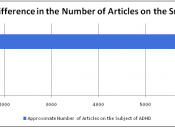Many children are diagnosed with learning disabilities every year. Approximately 1 in every 59 people has a learning disability. Over 4 million school age children go to school every day with a learning disability.(WrongDiagnosis.com, 2008). There are various learning disabilities that range from mild to the very severe. I will discuss ADHD, the most prevalent disability that has increased in social popularity over the past decade. I will discuss the causes, symptoms, and interventions of ADHD.
Attention deficit hyperactivity disorder is the most common behavior disorder in children and teens. ADHD refers to a group of symptoms that begin in early childhood and can continue into adulthood. It can cause difficulties at home, at school, at work and within the community if not recognized and treated. The exact cause of ADHD is not known. There is evidence to show that twenty percent of all cases of ADHD are caused by non-genetic factors.
(Wikipedia, 2008). Inherited genetic factors are likely responsible. Evidence has shown that hyperactivity has a strong tie to a person's genes. ADHD is a heterogeneous disorder, which means that more then one factor could lead to the disorder. Researchers believe that it arises from various genes which affect dopamine transporters. (Wikipedia, 2008).
Symptoms will vary from individual to individual, and can range from mild to severe. Symptoms of ADHD come in three groups. Inattention is the most common symptom, people with this symptom have difficulty paying attention and are often incapable to consistently focus, remember and organize. They may be lackadaisical and have a difficult time starting and carrying out tasks that are boring repetitive, or challenging. Impulsiveness, people who frequently act before thinking may not make sound decisions or work out problems well. They can also have difficulty developing and maintaining personal relationships. Adults with...



Fantabulous information
This is a short essay but contains good information. The information is to the point and allows those of us who are unaware of ADHD to understand it easy. The only constructive feedback that I have is not to star a sentence with "There are".
0 out of 0 people found this comment useful.